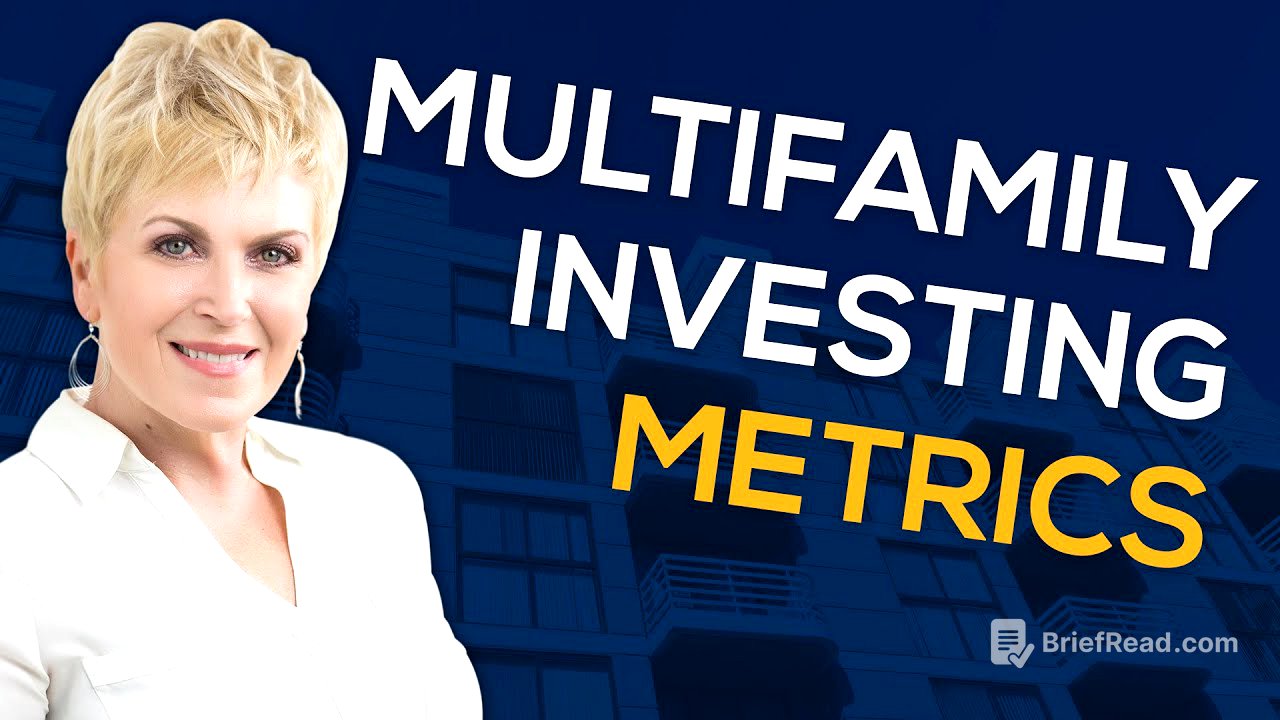TLDR;
This YouTube video, presented by Multifamily University, features Jay Scott discussing multi-family return metrics. The presentation aims to clarify common metrics used in multi-family syndication, including equity multiple, cash-on-cash return, preferred return, average annual return, and internal rate of return (IRR). It explains how these metrics are calculated, their benefits and drawbacks, and how they can be creatively used (or misused) by syndicators. Anna Myers also presents a value-add fund opportunity, highlighting past successes and current investment strategies.
- Equity Multiple: Indicates how much an investment is expected to multiply over the hold period.
- Average Cash on Cash Return: Represents the percentage of investment returned per year from property operations.
- Preferred Return: The percentage of investment returned per year before operators receive any profit.
- Average Annual Return: The percentage of investment returned per year from the overall investment, including equity events.
- Internal Rate of Return (IRR): The compounded return rate on the overall investment, assuming reinvestment of cash flows.
Introduction [0:03]
Anna Myers introduces Jay Scott, who will discuss multi-family return metrics. The session is recorded, and a PDF of the presentation will be available. Viewers are encouraged to ask questions in the Q&A. Jay Scott expresses his enthusiasm for presenting and assures viewers that the slides will be available, and he is open to answering questions after the presentation.
About Jay Scott [2:35]
Jay Scott introduces himself as a partner at Bar Down Investments, which invests in multi-family properties primarily in Texas and Ohio. He is the author of five books, including "Real Estate by the Numbers." The content of the presentation is based on a section of his latest book.
Return Metrics Overview [3:48]
Jay Scott introduces the basic information typically provided to passive investors in multi-family syndication deals, including the type of offering (506 B or C), the hold period, and the member manager split. The presentation focuses on return metrics such as equity multiple, preferred return, average cash on cash return, average annual return, and internal rate of return (IRR). He aims to explain these metrics, their benefits and drawbacks, and how operators can creatively use them.
Equity Multiple [7:16]
Equity multiple indicates how many times an investment is expected to multiply over the hold period. The formula is the ending value of the investment divided by the starting value. While it's a simple metric, it doesn't account for time, making it less useful for sophisticated investors. Operators can distort the view of the deal by not specifying the hold period, so investors should always ask if it's based on a five-year hold period.
Average Cash on Cash Returns [11:45]
Average cash on cash return measures the percentage of investment returned per year on average from property operations, excluding equity events like sales or refinances. It's calculated by dividing the annual cash flow by the initial investment. Operators can manipulate this metric by doing an "over raise," raising more money than needed and using the extra cash to boost cash flow, which dilutes investors' equity. Investors should ask if the operator is doing an over raise.
The Good, the Bad, and the Ugly of Cash on Cash Returns [20:52]
The good is that it indicates how hard the cash is working to generate more cash. The bad is that it's not necessarily representative of what investors will actually receive and is only indicative of the operational performance of the deal. The ugly is that operators can use an over raise to obfuscate the operational performance and dilute investors.
Preferred Return [23:08]
Preferred return is the percentage of investment returned per year before operators receive any profit. It sets a minimum bar for investor returns. Shortfalls in preferred return can either roll over to the next year or not, depending on the agreement. Investors should ask if shortfalls are rolled over.
The Good, the Bad, and the Ugly of Preferred Return [26:33]
The good is that it aligns incentives between operators and investors. The bad is that there's no guarantee of achieving the preferred return in any given year, and expectations can be poorly set. The ugly is that operators don't always accrue preferred return if there's a shortfall.
GrowCapitus Value-Add Fund Presentation by Anna Myers [29:18]
Anna Myers presents a value-add fund opportunity, highlighting past exits with high annualized returns. She notes that the company slowed down buying last year due to an overheated market but is now finding excellent deals. The fund will add three to four properties, targeting specific metros and neighborhoods. The presentation highlights Monarch Villas in Sandy Springs, Atlanta, as an example property with value-add potential. The fund offers tax benefits, with expected depreciation of around $60k for every $100k invested. Conservative projections include a 17-21% IRR and a 13-18% simple return.
Average Annual Returns [37:34]
Average annual return measures the percentage of investment returned per year from the investment overall, including equity events. The formula is the sum of all annual returns divided by the number of years held. A limitation is that it's an average, so investors are unlikely to see that exact return in any given year.
Limitations of Average Annual Return [40:47]
The presentation provides an example of three deals with the same average annual return but different ending balances due to the timing of returns. This illustrates that AAR doesn't necessarily indicate how much investors will end up with at the end of the deal.
The Good and the Bad of Average Annual Return [43:01]
The good is that it provides an easy-to-understand expectation for the average return on an annual basis. The bad is that it can be difficult or impossible to estimate actual profit without more information, and using AAR to extrapolate how much you're going to make on a deal can lead to underestimation or overestimation.
Internal Rate of Return (IRR) [43:34]
Internal rate of return (IRR) measures the compounded return on the overall investment. It's the compounding rate needed to get from the initial investment to the final value. IRR assumes that any money received back sooner is reinvested at the same rate.
IRR and Reinvestment [49:38]
The presentation explains how IRR assumes reinvestment of cash flows and provides an example where getting money back sooner results in a higher IRR, even if the total return is the same. This can be used by multi-family operators to boost returns for their syndications by returning money more frequently.
The Good, the Bad, and the Ugly of Internal Rate of Return [58:12]
The good is that IRR is the best tool to compare investments. The bad is that it's typically a theoretical maximum return. The ugly is that operators can manipulate IRR by returning money sooner, even if it doesn't result in a higher actual return for investors.
Q&A Session [1:00:45]
Jay Scott answers questions from the audience, including which metrics to focus on (not ROI), the tax implications of over raises (depends on individual tax situations), the advantages and disadvantages of preferred equity (higher returns than debt, lower risk than equity), and the outlook for multi-family over the next two to three years (bullish, resilient asset class). He also discusses industry benchmarks for cash on cash returns (5-7% is standard) and the importance of considering the whole picture when evaluating deals.

![AI Expert: Learn AI Agents Before 2025 Ends🔥[Build 5 AI Agents in 50 Minutes]](https://wm-img.halpindev.com/p-briefread_c-10_b-10/urlb/aHR0cDovL2ltZy55b3V0dWJlLmNvbS92aS9BUmEwVkNNOEpQdy9ocWRlZmF1bHQuanBn.jpg)







